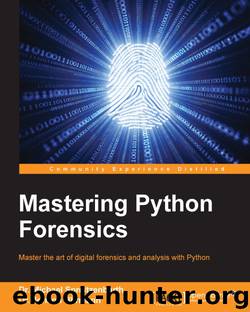Mastering Python Forensics by 2015

Author:2015
Language: eng
Format: epub, mobi
Publisher: Packt Publishing
Dshell can be installed in our lab environment by cloning the sources from GitHub at, https://github.com/USArmyResearchLab/Dshell and running install-ubuntu.py. This script will automatically download the missing packages and build the executables that we will need afterwards. Dshell can be used against the pcap files that have been recorded during the incidents or as a result of an IDS alert. A packet capture (pcap) file is either created by libpcap (on Linux) or WinPcap (on Windows).
In the following section, we will explain how an investigator can make use of Dshell by demonstrating the toolkit with real-world scenarios that are gathered from http://malware-traffic-analysis.net.
The first example is a malicious ZIP file that a user has encountered through an email link. The user logged in to Gmail and clicked the download link in the mail. This can easily be seen with the web decoder of Dshell, as follows:
user@lab:~$ source labenv/bin/activate (labenv)user@lab:~$ ./dshell (labenv)user@lab:~$ Dshell> decode -d web infected_email.pcap web 2015-05-29 16:23:44 10.3.162.105:62588 -> 74.125.226.181:80 ** GET mail.google.com/ HTTP/1.1 // 200 OK 2015-05-29 14:23:40 ** web 2015-05-29 16:24:15 10.3.162.105:62612 <- 149.3.144.218:80 ** GET sciclubtermeeuganee.it/wp-content/plugins/feedweb_data/pdf_efax_message_3537462.zip HTTP/1.1 // 200 OK 2015-05-28 14:00:22 **
Download
This site does not store any files on its server. We only index and link to content provided by other sites. Please contact the content providers to delete copyright contents if any and email us, we'll remove relevant links or contents immediately.
Kotlin in Action by Dmitry Jemerov(17308)
Grails in Action by Glen Smith Peter Ledbrook(15467)
Sass and Compass in Action by Wynn Netherland Nathan Weizenbaum Chris Eppstein Brandon Mathis(13331)
Azure Containers Explained by Wesley Haakman & Richard Hooper(7501)
Configuring Windows Server Hybrid Advanced Services Exam Ref AZ-801 by Chris Gill(7497)
Running Windows Containers on AWS by Marcio Morales(7054)
Microsoft 365 Identity and Services Exam Guide MS-100 by Aaron Guilmette(5436)
Microsoft Cybersecurity Architect Exam Ref SC-100 by Dwayne Natwick(5276)
Combating Crime on the Dark Web by Nearchos Nearchou(5018)
The Ruby Workshop by Akshat Paul Peter Philips Dániel Szabó and Cheyne Wallace(4701)
Management Strategies for the Cloud Revolution: How Cloud Computing Is Transforming Business and Why You Can't Afford to Be Left Behind by Charles Babcock(4550)
Python for Security and Networking - Third Edition by José Manuel Ortega(4274)
The Age of Surveillance Capitalism by Shoshana Zuboff(4253)
Learn Wireshark by Lisa Bock(4177)
Learn Windows PowerShell in a Month of Lunches by Don Jones(4077)
The Ultimate Docker Container Book by Schenker Gabriel N.;(3920)
Ember.js in Action by Joachim Haagen Skeie(3677)
DevSecOps in Practice with VMware Tanzu by Parth Pandit & Robert Hardt(3612)
Windows Ransomware Detection and Protection by Marius Sandbu(3579)
